- This article tells you about the story of Kumbh Parva, the science behind age old Hindu beliefs, on what basis is determined the site at which the Kumbh would be held, why Prayag, about Akshayavat, astrological significance, about different Sadhu Akharas and Sanyasi orders. Lastly, highlghts of Kumbh 2019 and names of must visit Mandirs.
यथा सुराणां अमृतं प्रवीणां जलं स्वधा ।
सुधा यथा च नागानां तथा गंगा जलं नृणाम ।।
The
Samudra Manthan & the struggle between Gods and Demons for Amrit signifies
the struggle between knowledge - wisdom and ignorance, meaning when control
over the pancha gyanaendriya, the pancha Karmendriyas is achieved, the Nectar
begins to emanate in the human body called Ghat/ Kumbh.
 Tweet by Hindustan Unilever "Kumbh Mela is a place where old people get abandoned etc"
Tweet by Hindustan Unilever "Kumbh Mela is a place where old people get abandoned etc"
Many
educated Hindus have for years believed the false narrative about the Kumbh
mela being a filthy place with millions taking a dip in dirty waters, not meant
for the educated, well to do, elite, where people get lost never to be found
again, of the youth taking advantage of crowds to abandon their old parents,
etc. Occurrences of stampeded in the years 1840, 1906, 1954, 1986 and 2013, in
the Kumbh Mela are quoted to further dig at the roots of Hindu religious
culture.
By 2016, the Simhastha Kumbh gained some faith among the urban society. 2019, many like oneself, going by the words of the present State and Central governments, gathered courage to take a plunge in the Holy Sangam at the Kumbh.
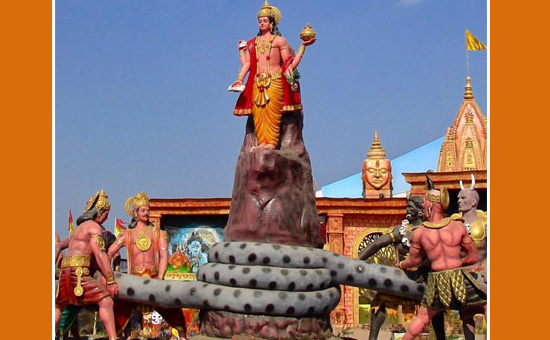 Samudra Manthan Prayag 2019
Samudra Manthan Prayag 2019
An intangible religious heritage of the Hindus, the
48 days Kumbh Parva is the largest human gathering on earth when The Hindu
saints and millions of devotees from around the world gather at the banks of
Ganga ji to celebrate the coming together of the earth, moon and Jupiter.
The spiritual hunger of a people, the strength of
Sanatan Samskriti, the collective intense longing of an entire population for
liberation that reflects in the Kumbh mela is practically impossible to capture
in words, film or print.
The gathering that dissolves all distinctions of
urban-rural, caste-class, rich and poor becoming one to soak in the nectar of
immortality, the ever flowing Ganga is a spectacle to be experienced. The
oneness of the massive Hindu society and its unfathomable faith in Sanatana
Dharma has to be seen to be believed.
In fact
despite many invasions, distorted narratives of malicious historians and
foreign funded liberals, walking kilometres after kilometres, rubbing
shoulders with lakhs of people for days in Prayagraj, one personally witnessed
the unchanged basic ethos, the undeterred faith in the occurrence called Kumbh.
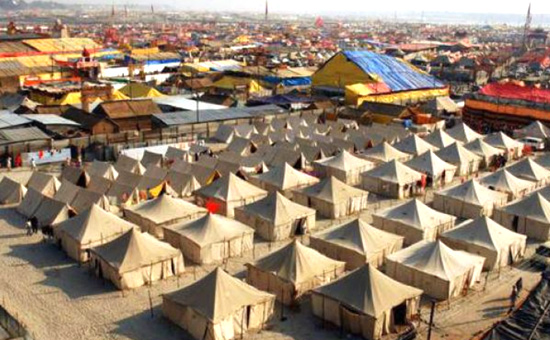 Tents at Prayag 2019
Tents at Prayag 2019
The story of Kumbh Parva
The
ancient origin of the Kumbh Mela is described in the Vedic Scriptures as being
evolved from days of the time when the Khsheer Sagar was churned over 12 days
by Gods (12 years in human time, theory of Relativity - time runs differently
in different realm of existence, E=mc2) with the Meru Mountain as the churning
rod, the king of serpents Vasuki as the rope around it.
On the
6th day of the Samudra Manthan, drops of elixir fell into the Ganga at
Haridwar, on the 9th day the ethereal subtle drops merged into the holy
waters of the Triveni Sangam of Ganga, Jamuna and Saraswati (existing only on
the ethereal plane, not visible to the human eye) at Prayag and on the
12th day in Godavari in Nashik and in Kshipra at Ujjain.
As per Rig Veda says:
सितासिते सरिते यत्र सङ्गते तत्राप्लुतासो दिवमुत्पतन्ति ।ये वै तन्वं विसृजन्ति धीरास्ते जनासो अमृतत्वं भजन्ते ॥ - Rigveda, Khilsukta
He who
bathes at the sangam attains Heaven, the courageous individuals who sacrifice
their body in this confluence attain moksha.
The Science behind the years old belief
of the Hindus
Different
planets take different amount of time to complete one revolution around the
sun. Jupiter moves from Aquarius, Taurus, Scorpio and Leo. When it enters
Aquarius (Aquarius- a pot pouring elixir on earth) the Kumbh mela is held and
when it enters other constellations Ardh Kumbh Melas take place.
Jupiter
rotates after every half an hour at a slow speed absorbing lesser energy from
the sun and releasing more, the place where it resides is destroyed but the
place at which it is directed flourishes. Jupiter takes 3 earth years to move
from one constellation to other & takes eleven years, ten months and
fourteen days to complete its revolution around the Sun. Hence the Purna Kumbha
occurs once in every twelve years.
The position of Sun, Moon and Jupiter in different astrological signs determine the site at which Kumbh will be held.
पद्मिनी नायके मेषे कुम्भ राशि गते गुरोः । गंगा द्वारे भवेद योगः कुम्भ नामा तथोत्तमाः।।
When the
Sun and Moon in Aries and Sagittarius respectively and Jupiter is in Aquarius
during the Hindu month of Chaitra, Kumbh is held at Haridwar.
मकरे च दिवा नाथे ह्मजगें च बृहस्पतौ कुम्भ योगोभवेत्तत्र प्रयागे ह्यति दूलर्भ:" मेष राशि गते जीवे मकरे चन्द्र भास्करौ । अमावस्या तदा योगः कुम्भख्यस्तीर्थ नायके ।।
When the
sun and the moon are in Capricorn and Jupiter is in Vrishabha/ Taurus during
the Hindu month of Magha, the kumbh happens at Prayag.
सिंह राशि गते सूर्ये सिंह राशौ बृहस्पतौ । गोदावर्या भवेत कुम्भों जायते खलु मुक्तिदः ।।
When the
Jupiter enters in Simha / Leo and the Sun and Moon in Cancer, the Kumbha is
held at Nashik and Trimbakeshwar.
मेष राशि गते सूर्ये सिंह राशौ बृहस्पतौ । उज्जियन्यां भवेत कुम्भः सदामुक्ति प्रदायकः ।।
When
Jupiter is in Leo and the Sun and Moon in Aries, the Kumbha is held at Ujjain.
Ardh-Kumbh
happens once in every 6 years in rotation at Allahabad, Haridwar, Ujjain and
Nasik. Poorna-Kumbh happens once in every 12 years in rotation at Allahabad,
Haridwar, Ujjain, Nasik. Maha-Kumbh happens once in every 144 years at Prayag.
Why Prayag?
Prayag is one of the three pilgrimage places
besides Kashi and Gaya.
Of the five Yagna Vedis, Kurukshetra, Gaya, Viraj,
Pushkar and Prayag, Prayag is the Madhya Vedi.
Prayag is called the ‘Akshaya Kshetra’, meaning when the entire world will be submerged at the time of Pralaya, Shri Vishnu will sleep on the Akshayavata, the abode of all Deities. All the Gods, sages and spiritually evolved individuals will reside here and protect the place.
त्रिवेणीà- ‚ माधवं सोमं भरद्वाजं च वासुकिम् ।
वन्देऽक्ष- यवटं शेषं प्रयागं तीर्थनायकम- ॥
I revere
Triveni Sangam, Venimadhav, Someshwar, Bhardwaj, Vasuki Akshayavat, Shesha
and Prayag, the king of pilgrimages.
Located on the sacred Triveni Sangam, where Ganga, Yamuna
and Saraswati meet, Prayag is also called Prajapatikshetra and Tirthraj. After
receiving the lost four Vedas Prajapati Brahma
performed his first Yagna here. Pra, a prefix and the root Yaj
means Yagna.
Akshayavat
नमस्ते वृक्ष राजाय ब्रह्ममं, विष्णु शिवात्मक।
सप्त पाताल संस्थाम विचित्र फल दायिने।।
नमो भेषज रूपाय मायायाः पतये नमः।
माधवस्य जलक्रीड़ा लोल पल्लव कारिणे।।
प्रपंच बीज भूताय विचित्र फलदाय च।।
नमस्तुभ्यं नमस्तुभ्यं नमस्तुभ्यं नमो नमः।।
Being the ‘Swaroop’ of Brahma, Vishnu and Mahesh, those sacrificing their body near the sacred ancient Akshayavat whose roots go deep till Patal, attain Moksha, say the Vayu, Matsya, Kurma, Padma, Agni and Skanda Puranas.
To smash the Hindu religious beliefs and practices, Akbar in 1575-84, destroyed the Akshayavat and the Mandirs around it and built Rani mahal over it, renaming Prayag as Ilahabas (changed to Allahabad by Shah Jahan) but the Akshaywat grew again. Jahangir set it on fire, placed hot iron plates over it to destroy its roots but the Akshayavat grew again into a giant tree standing tall with pride in Akbar’s fort on the banks of Yamuna.
Mughals then banned its darshan, the English continued with the ban. After Independence, its darshans were permitted only with prior permission from Commandant of Allahabad Fort's Ordinance Depot. In December 2018, Prime Minister Narendra Modi opened for year round darshan the Akshayavat, Patalpuri Temple and Saraswati Koop - source of the river Saraswati.
The astrological significance
The
ancient Rishis like Garga Muni, Aryabhatt, Kapila, Varahimira, Hayagreeva laid
down theories on planetary positions, eclipses, cosmography, law of gravity and
astronomical equipment.
The
Sun-Spot cycle enhances the electro-magnetic field of the earth effecting the
environment, water, air and the electro-magnetic field of the human body
producing effects on the nervous, endocrine, circulatory and the respiratory
system similar to that in meditation.
In each
universe, there are 14 planetary systems consisting of the three Lokas. These
three lokas are: Urdhva-loka, Madhya or Bhu-loka, Adho-loka.
These
Lokas/ planets exist within the material world, earth being in the middle of
these planetary systems, symbolizes the mortal realms known as Bhu Mandala.
Development of higher consciousness/ enlightenment starts with human beings. We
attains the higher lokas based on our spiritual evolvement/ enlightenment or
lower lokas because of our wrong deeds.
Nakshtara-Loka/
Lagoon Nebula, located near the major neighbourhood of the Solar System, seen
as the starry sky at night, represents the Zodiac Map around the Earth.
Position of the planets inside this Nakshatra
lokas play an important role in determining the incidents and future of an
individual.
“The sun revolves at the speed of 16,000 miles per second around the Dhruvaloka/ Galactic core, there is an area of an immense gravitational power and energy all around which is the connecting point between the Physical and Spiritual Realms”. - Srimad Bhagvat.
Modern
science calls these powerful areas of gravitational force, the black holes.
Dhruv-Loka
at the center, surrounded by a ring of stars, the complex planetary revolving
around the Dhruv Tara/ Polestar, is said to exist some 10,000,000 miles below
the Maharloka.
*So, this bright ring of stars as our galaxy Milky Way is the Vaikuntha,
the abode of Lord Ksirodakasayi Vishnu and all the objects attracted by black
holes reach the abode of Vishnu ji!
 Holy Waters at Prayag 2019
Holy Waters at Prayag 2019
The miraculous Holy waters and their changing
molecular structure
“Every living being is made up of water and minerals, so is the planet. Positive thoughts can harmonise related things. Prayers make water create beautiful hexagonal water crystals, negative ones create ugly looking water crystals, opposite vibration can be added to the water and by drinking that water, the negative feeling will go away”. - Dr Masaru Emoto
Ganga is deeply connected to the collective
consciousness of Hindus and is contained with their immense love and gratitude.
The self-purifying quality of the Ganga water have extraordinary ability to
retain oxygen levels, 25 times higher than any other river in the world.
Water being the quickest element to be energized,
changes its molecular structure with the changing solar magnetic activity. The
secret Moksha at the Kumbh lies in the Cosmic Energy, merging into the Triveni
Sangam spreading to a radius of 45kms. The human body absorb these Energies
that bring about changes in the mind and body helping in further evolution or
liberation of the soul.
At Haridwar, this Cosmic Energy gushes in the Ganga
at the point of Har-ki-Pauri, At Ujjain in the centre-point of Shipra adjoining
to the Mahakaaleshwar, at Nasik in the Godavari at the point that flows by
Triyambhakeshwar.
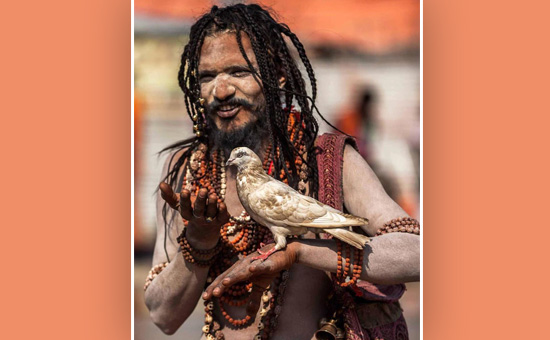 Naga Sadhu
Naga Sadhu
Fortunate are those
‘It is extremely rare to have the privilege of a Holy bath in Prayag in the month of Magha’. -Padmapurana.
‘A holy bath every day at Prayag is equivalent to the benefit obtained by donating millions of cows.’ - Agnipurana.
‘It is equal to performing Ashwamedha Yadnya.’ - Brahmapurana.
’It is equal to the pilgrimage to more than 100 crore shrines.’ -Matsyapurana.
‘Brahma Himself was unable to describe the benefits obtained by dean and a holy bath on Makar sankranti at Prayag.’ - Mahabharata.
Sadhus,
the centre of attraction
Sadhus of various Akahras, (Akhara, from akhand, meaning undistructable) are an integral part of the Kumbh Mela, who come out of their seclusion for pilgrims who seek their blessings & divine energy.
There are hundreds of different Hindu Sanyasi
orders. The Sanyasis dedicate their lives to the pursuit of self-realization
and renouncing of all possessions, take a vow of non-injury, truth,
chastity and follow a strict discipline of overcoming anger, service and
surrender to the Guru, alertness, cleanliness, wearing simplest unstitched
clothes, sleeping on the ground and purity of food.According to some of our scriptures Sri Dattatreya founded Sannyasis Orders. According to some of our scriptures Sri Dattatreya founded Sannyasis Orders.
The Shaiva Akahras follow Shiva.
Vaishnava Akharas worship Vishnu
Udaseen Akharas Chandra Dev, the son of the first
guru of the Sikhs is considered as the founder of the Udaseen Akhara.
 Naga Sadhus
Naga Sadhus
More than a lakh Naga Sadhus from thirteen Akharas were the centre of attraction at the Kumbh 2019.
The Naga Sadhus - Naga in Sanskrit means mountain, people residing in and around mountains are known as Pahadi or Naga. Around 2500 years ago Adi Sankaracharya formed, ‘Shastra ki fauj’ and ‘Shastra ki fauj’, the order of Naga Sadhus to fight the invading Muslims and to protect the religion;
A warrior class, the Nagas were trained and divided
like a regiment in an army and are ready to fight intellectually or wrestle
anytime.
Most of the Nagas enter the orders at a very young age and live a life of celibacy for six years and after 12 years they are accepted as a Naga.’ - Naga Digambar Kedar Giri,
Otherwise confined to their caves in Himalayas, only
at the Kumbh the Sangam of the Naga sadhus can be seen meditating, transforming
people and meeting each other.
In the honour of the protectors of Dharma, Nagas to take the first ‘Amrit Snan’ in Ganga ji became a traditional ritual at Kumbh.
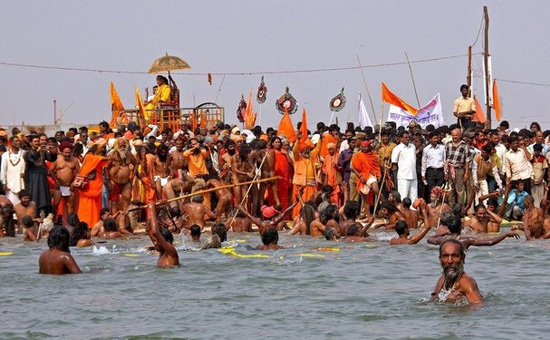 Going for Snan in Holy Waters
Going for Snan in Holy Waters
Some
Sanyasi orders
Urdhwavahur Sadhus - undergo rigid spiritual practices.
Parivajakas - take a vow of silence & use bells to alert others to their presence.
Shirshasinsins - stand for 24 hours and meditate in headstand posture.
Dandi Bara/ Dandi sanyasis - carry wooden sticks called Bhramha Danda. It is said that Narayana himself was the first Dandi Sanyasi.
Acharya Bara - sect is also known as ‘Ramanuj Sect. The first Acharya of this sect was Shri Shathkop Swami of South India, a devotee of Shri Vishnu about 4,500 years ago.
Prayagwals - The descendents of Tirth Purohit of Raghukul in Treta Yug. In ancient times the huts of Prayagwals were the main residing place for pilgrims to Kumbh and the offerings received from the travelers was their source of living. Since then all religious rites of pilgrims at Prayag are conducted by them. The head Tirth Purrohits of every state live in Prayag.
Kalpvasis - live on the banks of Ganga throughout the Kumbh, meditating, performing rituals, bathing three times a day, control their senses and with a Sakshi bhaav, surrender themselves to Bhagwan Vishnu. According to Dharma Granths, Kalpvas satisfy our ancestors.
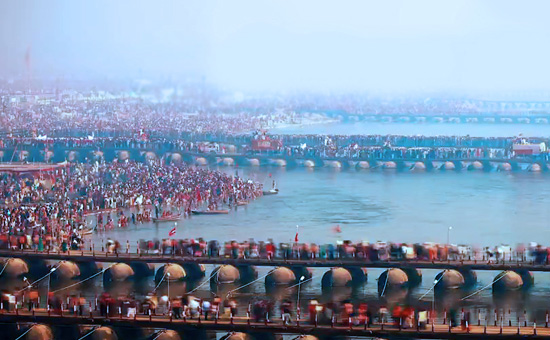 Pontoon Bridge
Pontoon Bridge
Highlights
of Kumbh Mela 2019
Unlike the earlier times when the area allocated to
the Kumbh Mela used to be 15 to 17 kms, this time around the state government
spread it over an area of 45 km; from 5,000 acres to 10,000 acres.
Tanneries in Kanpur and Unnao were closed from
December 15, 2018, till March 15, 2019, to maintain the cleanliness of
Ganga.
Largest temporary city in the world has been set up
along Prayagraj, with 250-km long roads and 22 pontoon bridges.
More than 40,000 LED bulbs brighten the Kumbh Mela. 'Intangible Cultural Heritage of Humanity.’- UNESCO
Two ‘Integrated Control and Command Centres’ and the use of ‘artificial intelligence’ with over 1,000 CCTV cameras, Quad bikes for quick movement on the sand of the Sangam area, for better crowd management, safety and traffic movement control, was witnessed for the first time ever in a Kumbh Mela.
The Indian Railways ran 800 special trains to Prayagraj at Rs.5, Air India flew new flights. ‘Joyride’, helicopter service for a tour of Kumbh 2019 was an interesting addition.
Stalls
playing videos of events at Kumbh 2019 with a VR headset for a virtual reality
experience were set up.
Around
4000 high-speed Wi-Fi hotspots across the mela were set up. About 1,22,000
toilet were constructed and a lakh swachhagrahis deployed to look after the
hygiene and cleanliness.
There were around 50 milk booths and 40 stalls in
the food court area.
UNESCO listed Kumbh Mela on its list of ‘Intangible Cultural Heritage of Humanity’. Yoga was added on the list on December 1, 2016.
Must Visit Mandirs
Prayagraj
is known as Madhavakshetra, Vishnu ji himself resides here in the form of 12
Madhavas; Shankh Madhav, Chakra Madhav, Adi Madhav, Gada Madhav, Bindu Madhav,
Manohar Madhav, Triveni Madhav, Assi Madhav, Anant Madhav, Pad Madhav,
Sankathar Madhav and the Principal Madhav, Venimadhav.
Venimadhav Mandir, Nirala road of Daraganj
Someshwar
- near Bindumadhav, Arail
Akhileshwar Mahadev, Rasulabad Ghat road
Takshakeshwar Nath, Dariyabad
Dashashwamedha Temple, Daraganj - Where Brahma ji
performed Ashwamedha Yagya.
Bhardwaj and Shesha, Colnel Ganj, George Town - The Ashram of Bharadwaj Rishi, the Shivalingam in this Ashram is called ‘Bharadwajeshwar’ and there is a Shesha Moorti with one thousand hoods.
Vasukishwar,
the King of the serpents - The Vasuki Temple on the banks of the River Ganga in
Bakshi Peth.
Sankatmochan Hanuman, Daraganj
If you’ve missed this Ardh Kumbh, take a leap of faith into the next Kumbh after six years in 2025 and experience the monumental religious gathering, the only one in the world. Shed all apprehensions and plunge into the mesmerising
ocean of spirituality.
Author is a hospitality entrepreneur. She is an avid history buff and perpetually researches episodes where history was faulted to manufacture faux narratives. She says “History is the mother of future and correct history is a debt we owe our future generations”.
To read all articles
by Author
Also read
1 All
you wanted to know about the Kumbh Mela
2 Pics of
Haridwar Kumbh 2010